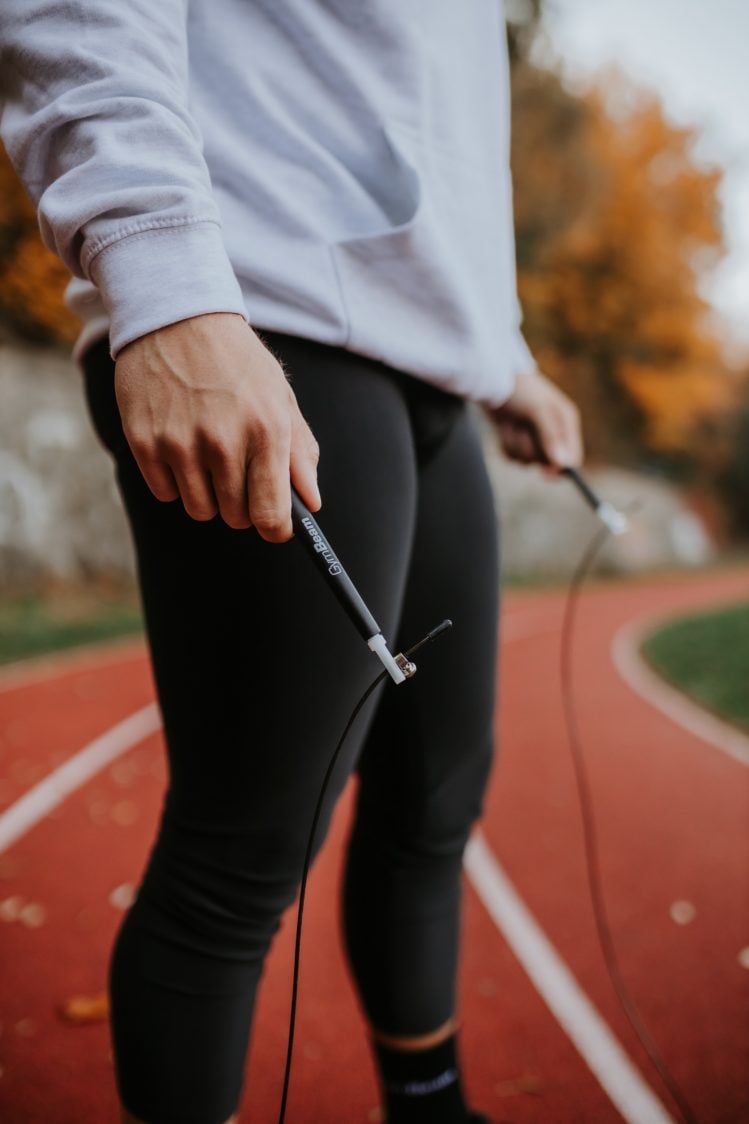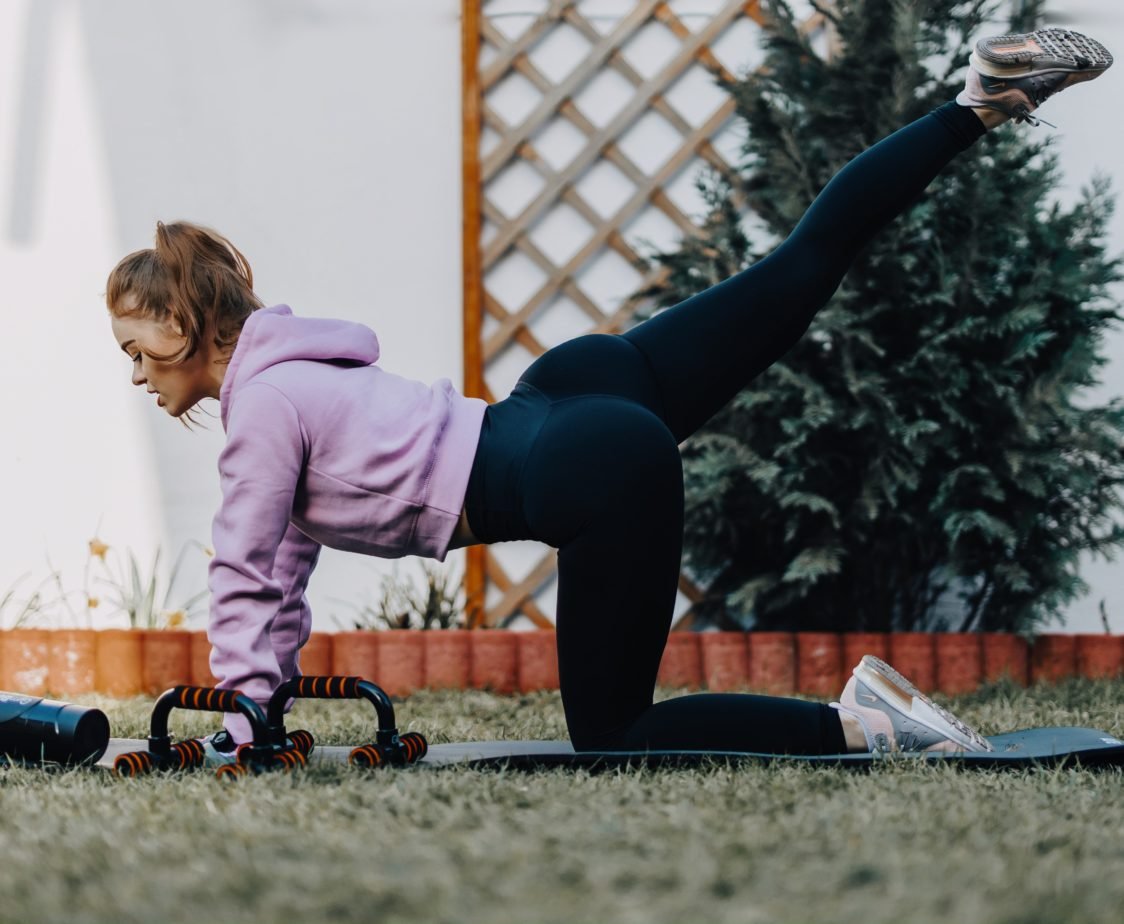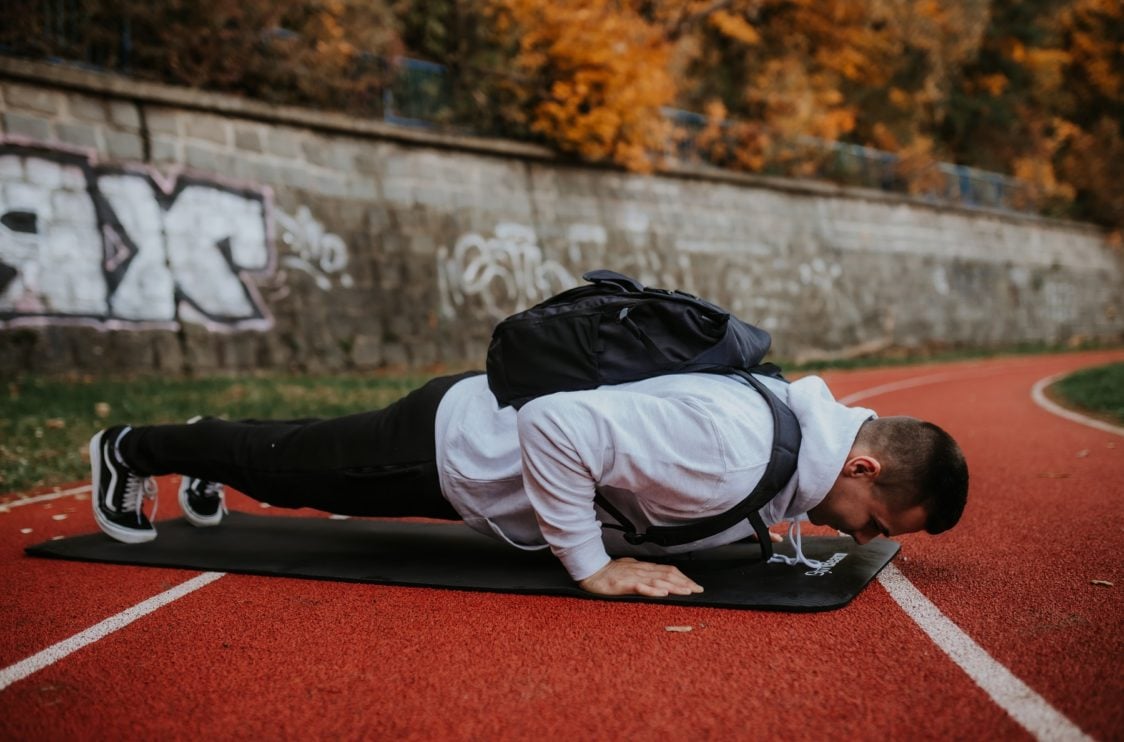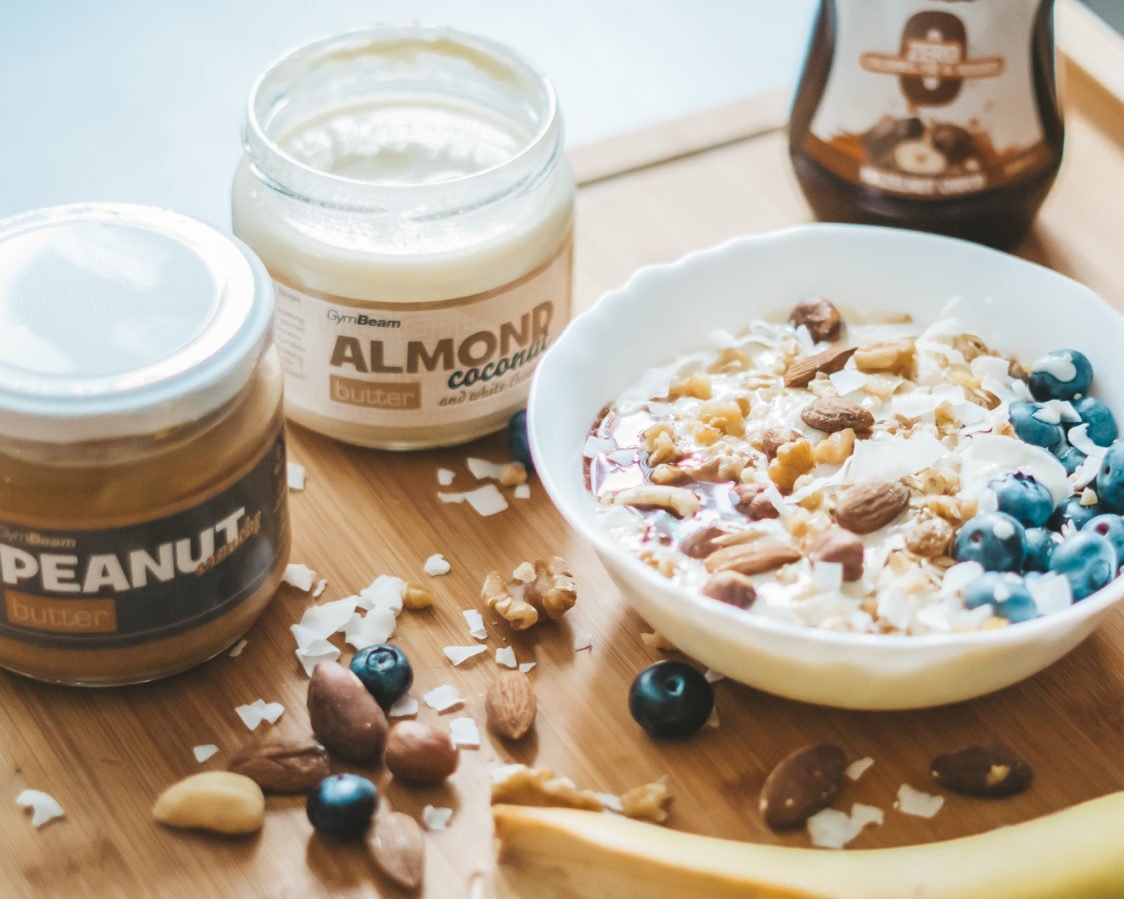Table of Contents
When you think of cardio, you certainly imagine a workout with popular gym machines like exercise bike, elliptical, rowing machine, stepper, and many others.
There are many options for doing cardio outdoors too. You can get on a bike, go ice skating, jogging, or ride a scooter. But what to do when the gym is closed and the weather is so bad that you don’t even want to think about doing sports in the rain and wind?
In that case, there is only one solution – at-home cardio. Don’t know how to do it? In today’s article, we will introduce 12 best tips for at-home workout.
Why is it important to do cardio?
Firstly, let’s talk about what the term cardio actually means and why this activity should be important for you. Cardio in the fitness world represents long-lasting endurance activity. It is sometimes referred to as aerobic activity. According to medical recommendations, we should do at least a 150-minute activity of medium intensity or a 75-minute activity of high intensity every week. If you do some physical activity regularly, you may gradually feel an improvement in health and general quality of life. [1]
4 Most Important Benefits of Cardio
1. Health Improvement

Regular activity will improve your cardiovascular system, which will reduce your blood pressure or the risk of a heart attack. Cardio takes work off your heat as well. If you exercise regularly, your heart will be able to pump the same amount of blood with fewer beats. This can make his job easier, and also extend its longevity. [3]
It may also contribute to a lower risk of developing bladder, breast, colon, or stomach cancer. Exercise also has a positive effect on the regulation of blood sugar levels, which is vital for diabetics. [2] [4]
From a health point of view, cardio has positive effects on immunity. If you incorporate enough exercise and give your body enough time to recover, you will strengthen the body’s defense and be more immune to viruses and bacteria. It can also help people with asthma because it can reduce the frequency and severity of asthma attacks. [5] [6] [7]
2. Sleep Improvement
Cardio has a positive effect not only on health but also on sleep. This has been confirmed by the results of a study that focused on individuals with chronic sleep problems. Participants were engaged in regular endurance training and then completed a questionnaire form regarding their feelings. In addition to longer and better sleep, they also mentioned other benefits, such as improved alertness and vitality.
However, we must say that falling asleep and sleep quality is very individual. In general, you should not exercise less than an hour before going to bed. If you have trouble falling asleep, you should stop doing any kind of cardio activity no later than 3 hours before going to bed, otherwise, you might be staring at the ceiling and counting sheep for hours.
3. Fat Loss
Probably everyone is already familiar with the fact that exercise burns calories, which can ultimately lead to weight loss. Above all, it is necessary to mentioned how can cardio affect fat loss. To conduct a study, researcher Donnelly and the team gathered 141 overweight or obese participants. Participants were instructed to live in the same way as before for ten months, but they also had to perform an aerobic activity (cardio) five times a week, during which they had to burn 400-600 kcal. They could eat to satiety, they did not have a precise diet. The results showed a statistically significant change in weight, with about 5% of weight loss. [9]
You may think 5% of weight loss is not enough. However, it is necessary to take into account that the participants were allowed to maintain the so-called ad libitum diet, which means eating until you are full. However, if you adjust your calorie intake and do some cardio, sooner or later you will see the results.
How do I adjust my calorie intake when I want to lose weight?
As an example, we can use a person who is 170 cm tall and weighs 80 kg, let’s call her Petra. In this case, she is overweight, as are some participants in the previous study. Let’s say that she no longer loses or gains weight, she simply maintains her weight with her current lifestyle.
If Petra lived the same way as before and did cardio five times a week, she would burn 500 kcal, therefore 2500 kcal per week.
For example, Petra would burn 500 kcal with the following activities:
- an hour of jogging at 6 km/h of speed
- an hour of cycling without incline at 15 km/h of speed
- an hour of freestyle swimming – recovery pace
- 2 hours of housework
Assuming she will remain active for half a year and not taking into account body adaptation and other side factors, she can burn 65,000 kcal in 6 months. Having said that, a kilo of fat is approximately 7700 kcal, therefore, we see that Petra could lose approximately 8.5 kg of fat in half a year, bringing her from overweight to normal weight.
With this example, we can see that with enough exercise, it’s really not that difficult to get rid of excess weight. You need to do it systematically and with no fast and magical expectations.
4. Improvement of Brain Function and Mood

In one research, Colcombe and his team studied the effect of cardio activity on cognitive functions, specifically on a sample of 55 older adults. Throughout ageing, there is usually a significant decrease in tissue density, which results in a decline in cognitive functions. Through magnetic resonance imaging, researchers have found that regular aerobic activity leads to a moderation of the age-related decline in tissue density, and thus to a slower decline in cognitive functions in old age. [10]
However, when it comes to brain function, you don’t have to start doing cardio once you are older. Your body will also benefit from it in your youth. If you have a difficult exam or a hard day at work, a morning cardio can help increase concentration during the day. Also, evening exercise can perfectly clear your mind from all the worries.
If something is bothering you or you are stressed, try an hour of cardio and you will immediately feel better, meaning that the problems will become more bearable.
You might be interested in these products:
7 Benefits of Home Cardio Training
The previous points may have convinced you that aerobic activity has many positive effects on the overall quality of your life.
Why should you choose to do cardio workout at home?
- You will save time as you do not have to go anywhere.
- You will save money on your gym pass.
- You will save money on equipment. You can train without it. However, for example, a jumping rope, which can cost you about the same as one or two gym passes is a great tool for your workouts.
- You don’t have to worry about whether you look good. If you feel that someone is constantly staring at you in the gym, you won’t get the looks at home.
- You don’t have to worry about bad weather. It doesn’t matter if it’s raining or too windy. Your home workout will be still the same.
- You can play music that you love out loud.
- You don’t have to worry about someone occupying your training space or machine.
To stay motivated for your at-home workout read our article 5 Tips to Stay Active, Motivated and Never Stop Exercising Even at Home.
12 Tips for Home Cardio Training
There are many effective cardio exercises you can do at home. You can alternate different exercises, intensity, and duration, thanks to which you have a variety of different options. To make it easier for you to get started, we’ve selected 12 different options of what home cardio training might look like. We will also state the so-called MET, which is a unit expressing the energy you spend while a particular activity in relation to sitting at rest. For example, if an activity has MET 4, it means that you burn four times as many calories as if you were just sitting at rest.
MET 1 is, therefore, equal to one hour of lying at rest. To use MET to find out the specific number of calories that you burn in an hour by a particular activity, you have to multiply it by our weight.
For example: If a person weighs 50 kg and performs an activity that has MET 10 for an hour, he/she will burn approximately 500 kcal during this time.
How many calories can you burn with at-home cardio exercise?
1. Jumping Rope

You probably remember childhood days when jump rope was a fun exercise. Since kindergarten or school, children know how to use it. Let’s confess: when was the last time you used a jumping rope? We bet it’s been quite some time.
Moreover, we have some good news for you. Just like riding a bike, you cannot forget how to use a jumping rope. Plus, it is a really effective way to warm up your whole body, force it to burn calories and improve your physique. No wonder that it is so popular among boxers and cross-fitters.
There are many ways to jump rope:
- skipping with a between jump
- basic skipping in a tempo
- jumping on one leg
- alternate foot skipping at one place
- criss-cross skipping
- double unders
At first, try basic jumps so that you can get used to exercise and gain confidence in the process. Over time, you can add up on the intensity, and work your way up to alternating between double jumps with a criss-cross and jumping on one leg. You will see that jumping rope is so much fun.
MET value: High-intensity jump rope workout is approximately MET 11.
In practice it means:
- A 60 kg woman will burn approximately 660 kcal in an hour.
- An 80 kg man will approximately burn 880 kcal in an hour.
2. Hops – front kick, back kick, high jumps

Since being a child, you will certainly know those types of exercises that were used to warm up during PE classes. Various jumps (eg running ABC’s) are also used by athletes to warm up before training or a match.
What exercises are we talking about?
- mummy kicks
- butt kicks
- jumping on one leg
- side jumps
- Heisman’s
- tuck jump
There are many variants of jumps and hops. To make your training fun, you can alternate between different variants, and the hour of training will pass like a breeze. Even during your home training, we recommend wearing shoes that cushion the impact or jump on a mat to avoid knee pain.
MET value: The combination of different hops has approximately MET 9.
In practice it means:
- A 60 kg woman will burn an average of 540 kcal in an hour
- An 80 kg man will burn an average of 720 kcal in an hour
3. Jogging
Jogging is usually an outdoor exercise. But have you thought of trying jogging at home? If you live in a big house, you can do it by moving around the rooms while listening to our podcast. If you live in a small flat, you can try jogging in one place. When you watch your favourite YouTube videos or series on Netflix, an hour seems like nothing.
Met value: Jogging in one place is approximately MET 8.
In practice it means:
- A 60 kg woman will burn approximately 480 kcal in an hour.
- An 80 kg man will burn approximately 640 kcal in an hour.
4. Jumping Jacks
This exercise is a part of almost every fitness YouTube video. Many people love this exercise. No wonder, it is an exercise that workout out the whole body. Although it looks simple at first glance, we guarantee that you will get really sweaty.
It is simple. Start with a standing position, legs together, arms at your sides. Jump up and spread your legs. Stretch your arms out and over your head. The arms should be in one line with the body, do not bend them. Then repeat. This way you can perform it for a long time.
If you want to push your limits with jumping jacks, we recommend, for example, alternating, a minute of maximum speed with two minutes of a slower tempo. Your workout will get to an end in no time.
MET value: Jumping jacks has approximately MET 8.
In practice it means:
- A 60 kg woman will burn approximately 480 kcal in an hour.
- An 80 kg man will burn approximately 640 kcal in an hour.

5. Burpees
Some people hate them, others cannot imagine living without them. Yes, we’re talking about burpees. If you are already a part of any of those two teams, you will surely agree that it is a very effective exercise that targets many muscle parts and it will push your stamina really hard.
How to do burpees? Let’s start with the basic position. Stand upright, with your feet shoulder-width apart, arms at your sides. Quickly lower into a squat, place our hands on the floor, and jump your feet back into a plank position. Then jump your feet back and go up again.
You can modify this exercise in many ways:
- add a push-up
- add a push-up with a clap
- hold a plank on one leg
- add mountain climbers
- add a weighed west or a backpack
As with the previous exercises, you may change the intensity as needed.
MET value: Burpees have approximately MET 11.
In practice it means:
- A 60 kg woman will burn approximately 660 kcal in an hour.
- An 80 kg man will approximately burn 880 kcal in an hour.

6. Sliding Exercises
Maybe you already had the honor to train on the so-called flow-in exercise mat. Yes, it’s a serious killer. You may be happy when we tell you that you can work out your muscles even without it. If you feel that the flow-in exercise mat would take up a lot of space, you can try sliders, which will do the job. However, you can also replace them, for example with an old cloth that will slide on the floor. In addition to working out your entire body, you will also perfectly polish the floor.
How to use sliders? Start with a plank position, hold your core nice and tight, with hands on the floor. Then you can either pull the knees in to touch your chest, slide them together, do side knee tuck, mountain climbers, jacks, and so on. If you want to increase the load, put a weight on your butt (for example, a book or a filled backpack), or put on a weighted vest. Another option is to alternate and do push-ups. We guarantee that your core won’t be the only thing burning.
MET value: The mentioned sliding exercises have approximately MET 11.
In practice it means:
- A 60 kg woman will burn approximately 660 kcal in an hour.
- An 80 kg man will approximately burn 880 kcal in an hour.
7. Bodyweight Exercises
There are a lot of exercises in this category, so you don’t have to worry about your workout routine becoming boring. If you decide to include body weight exercise as cardio, keep in mind that this should be a continuous, long-lasting exercise. It is not advised to go to your maximum and then take breaks. In this case, it would be more of a HIIT training.
You can try:
- conventional squats
- one leg squats
- lunges
- push-ups
- box step-ups (you can use your couch)
- sit-ups

If you alternate the individual exercises, you can perfectly train your entire body. You can set 2 minutes for each exercise, and start the next one. This way you can repeat the whole round several times. So that you don’t have to keep track of time, we recommend to download Tabata timer, where you can set the signaling at different time intervals, and you can then really focus only on the exercise. If you would like to make it even more difficult, you can use, for example, a suspension training set.
Moreover, a suspension training set can make some exercises easier to perform. For example, you can learn how to do squats on one leg as you can hold on to the straps while performing the exercise. You can also try doing jumping squats or lunges, and engage your arms in this way.
MET value: In the mentioned bodyweight workouts, MET can vary. Depending on the difficulty of the exercises and the intensity, it can vary somewhere between 6 – 10.
In practice it means:
- A 60 kg woman will burn approximately 360 – 600 kcal in an hour.
- An 80 kg man will burn approximately 480 – 800 kcal in an hour.
8. Boxing

Don’t have a punching bag at home? You don’t need it at all! Even the best boxers use the so-called method of shading as they fight against an imaginary opponent while trying to hit him with various punches. You can also train this way. Imagine your worst enemy facing you and punch him with a few hits and kicks.
Remember that your imaginary enemy is also defending himself, so your training should not lack squats and other moves. If you turn on the music and try to box to the beat, it will definitely become fun cardio to do.
MET value: Boxing has approximately a MET of 5.5.
In practice it means:
- A 60 kg woman will burn burn approximately 330 kcal in an hour.
- An 80 kg man will burn approximately 440 kcal in an hour.
9. Jacík’s test
With this test, you will train your whole body. Besides, you can also learn about your physical fitness. This is the way how applicants for sports studies, or police officers are tested for their physical condition. If you perform this test for 2 minutes max, you can then check how well you would pass the job interview. Of course, you can perform it at a slower pace even longer than two minutes, or switch between exercises.
How does Jacík’s test look like? Start in a back stand position, lie down on your stomach, go back back to a standing position, and then to lie on your back. Perform these 4 positions at the fastest possible pace one after another.
MET value: Jacík’s test is approximately MET 10.
In practice it means:
- A 60 kg woman will burn approximately 600 kcal in an hour.
- An 80 kg man will burn approximately 800 kcal in an hour.
10. Dancing

Have you ever tried to turn on the music to the max and pretend you are on performing and dancing on the concert? If not, you don’t know what you are missing. Not only will you enjoy your concert properly, but in addition, dancing is a great cardio that will keep you entertained. You can alternate slower songs with wild rhythms and get rid of all the excess energy.
Try doing it especially when you are home alone because you probably might not look as attractive as you think. It’s definitely great fun and effective training to burn a significant amount of calories.
If you feel that you cannot move to the beat on your own, try to find a dance video to learn the basic steps. For example, game consoles can help, where you try to mimic the movements of a figure on the screen.
MET value: Dancing has approximately a MET of 7.8.
In practice it means:
- A 60 kg woman will burn approximately 468 kcal in an hour.
- An 80 kg man will burn approximately 624 kcal in an hour.
11. Fitness Tidying-up
Unfortunately, we all have to clean and tidy up the house. The same goes for exercise. How to solve this when you do not have much time and have to decide between these activities? How about trying to combine them together? In addition to a sweaty T-shirt and increased endorphins, you will also be rewarded with a perfectly tidy apartment.
How should the housework workout look like?
- Plan the activities you need to do – for example, collect dirty clothes in the apartment, hang clothes, wipe dust, and wash the floors.
- Think about the exercises that could be combined with the cleaning activities and make a plan in your head.
- Get started. You can do 10 burpees for every single piece of laundry you pick up from where it doesn’t belong. When hanging laundry, you can always do 3 squats before hanging one piece (yes, a washing machine full of socks becomes an even bigger nightmare at this moment), when wiping dust you can do 5 push-ups on each wiped area and you can combine washing the floor with already mentioned dancing.
An hour of tidying up will put you in a good mood and maybe it will teach you some good habits. Next time, you will definitely think twice before putting the dirty laundry on the treadmill or any other place it does not belong to. Otherwise, you will have to do 10 burpees before taking it to the laundry basket.
MET value: House cleaning workout is approximately MET 6.
In practice it means:
- A 60 kg woman will burn approximately 360 kcal in an hour.
- An 80 kg man will burn approximately 480 kcal in an hour.
12. Bonus Tip – Sex
You may have never heard about how many calories you can burn with sex. In that case, we may disappoint you. Most often, we don’t get into any huge numbers. Of course, this is an activity that you will probably want to do the most. In addition, you will also enjoy quality time with your partner. However, if you want to burn calories, it will probably be more appropriate to do, let’s say, some rope skipping instead.
MET value: Sex has approximately a MET of 1.8.
In practice it means:
- A 60 kg woman will burn approximately 108 kcal in an hour.
- An 80 kg man will burn approximately 144 kcal in an hour.
How Many Calories Can We Burn Thanks To Cardio?
If we take into account the average values of calories burned during mentioned cardio activities, we will find out that a 60-kilo woman can burn approximately 520 kcal in an hour by aerobic training and an 80-kilo man can burn approximately 692 kcal in an hour.
How to imagine this amount in specific meals?
FOOD | ||||||
|---|---|---|---|---|---|---|
If you want to eat back your calories burned by this one-hour cardio session and have milk chocolate or cashew butter, it should look something like this:
- 60 kg woman could eat 82 g of cashew butter or milk chocolate
- 80 kg man could eat 110 g of cashew butter or 125 g of milk chocolate

What to remember?
Cardio activities undoubtedly have a positive effect on our physical and mental health, and therefore we should exercise several times a week. The fact that gyms are closed and the weather is bad doesn’t have to discourage you from exercising. There are countless ways to do cardio at home. As a result, you can burn a large number of calories, which you can eat back and have with various foods, as is listed in the table above. If you would like to learn more about eating and creating a meal plan, you should not miss our article How to calculate energy and macronutrient intake for weight loss or muscle gain?
When doing cardio workout, don’t forget to combine different exercises and alternate intensity. Thanks to this, you will not get tired of the exercise, you will also be able to benefit from the aerobic activity in the long run. Do you also have a favourite cardio exercise that you can do at home? Share it with others in the comments below. You can never have too much of inspiration.
[1] Centers for disease control and prevention Atlanta – Physical Activity for a Healthy Weight – https://www.cdc.gov/healthyweight/physical_activity/index.html
[2] Centers for disease control and prevention Atlanta – Physical Activity for a Healthy Weight – https://www.cdc.gov/healthyweight/physical_activity/index.html
[3] Friedenreich, Orenstein (2002) – Physical Activity and Cancer Prevention: Etiologic Evidence and Biological Mechanisms – https://doi.org/10.1093/jn/132.11.3456S
[4] Yang, Scott – Resistance Exercise Versus Aerobic Exercise for Type 2 Diabetes: A Systematic Review and Meta-Analysis – https://link.springer.com/article/10.1007/s40279-013-0128-8
[5] Pedersen, Bruunsgaard (1995) – How physical exercise influences the establishment of infections – https://pubmed.ncbi.nlm.nih.gov/7676100/
[6] Campbell, Turner – Debunking the Myth of Exercise-Induced Immune Suppression: Redefining the Impact of Exercise on Immunological Health Across the Lifespan – https://pubmed.ncbi.nlm.nih.gov/29713319/
[7] França-Pinto a kol. – Aerobic training decreases bronchial hyperresponsiveness and systemic inflammation in patients with moderate or severe asthma: a randomised controlled trial – https://thorax.bmj.com/content/70/8/732
[8] J.Reid a kol. – Aerobic exercise improves self-reported sleep and quality of life in older adults with insomnia – https://www.sciencedirect.com/science/article/abs/pii/S1389945710002868
[9] Donnelly – Aerobic exercise alone results in clinically significant weight loss for men and women: Midwest exercise trial 2 – https://onlinelibrary.wiley.com/doi/full/10.1002/oby.20145
[10] Colcombe a kol. – Aerobic Fitness Reduces Brain Tissue Loss in Aging Humans – https://academic.oup.com/biomedgerontology/article/58/2/M176/593589
[11] Compedium of Physical activities – https://sites.google.com/site/compendiumofphysicalactivities/


Add a comment